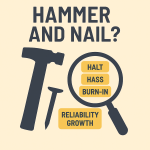
Getting the right parts for your maintenance isn’t quite as easy as you might think. To begin with they must be included in your spares inventory and stocked on your site. If not, they must be purchased when needed. If you are reacting to a breakdown, you will need them in a hurry, and you may find yourself short. Why does that happen? And, what can you do about it? Missing parts can cost you time – time that the equipment is down and not producing. Your operators are idled and your supply chain folks are scrambling to help you. That increases maintenance and operating costs, reduces production output and reduces available working capital. Those parts are like gold to your operation!
[Read more…]












